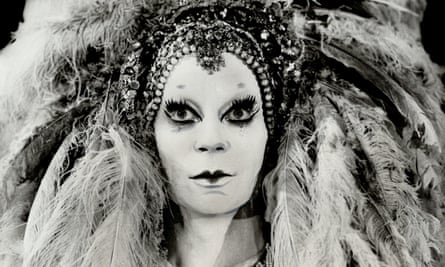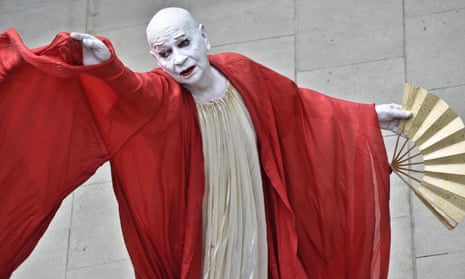The mime artist, dancer and choreographer Lindsay Kemp, who has died aged 80, combined the subversive European strain of Jean Cocteau, Jean Genet and Federico García Lorca with the British punk and glam-rock strut of the mid-1970s. An acknowledged mentor to both David Bowie and Kate Bush – he staged Bowie’s famous Ziggy Stardust concerts at the Rainbow, Finsbury Park, in north London, in 1972 – he was also a hugely popular performer with his own company, and Ballet Rambert, at Sadler’s Wells and worldwide.
But, as with other groundbreaking or provocative choreographers such as Pina Bausch or Mark Morris, he faced immense critical hostility and, unlike Bausch and Morris, never grew to be loved by dance critics. His work was more often favourably reviewed by theatre critics. Still, he left Britain for good in the late 70s, for Spain and then Italy, although he did make a successful return to Sadler’s Wells in 1983, dancing Nijinsky as a white-faced, slow motion rag doll in the last stages of insanity.
The point at issue always with Kemp was whether or not he was a “proper” dancer or a facetiously camp hybrid of mime, performance art, operatic gesture and a sort of defiant, heroic sexuality. Because he fitted no category, was never averse to expressions of flagrant eroticism on stage and DJ’d Judy Garland with the Mozart requiem, he was variously described as a self-indulgent trash-monger, the “British bizarro” and an epicene purveyor of tripe. He embodied, unsurprisingly, a glam rock panto dame in Todd Haynes’s Velvet Goldmine (1998), a film in which Ewan McGregor and Jonathan Rhys Meyers played cultish rock singers.

There was undoubtedly an element of self-conscious martyrdom and masochism in the way he offered himself to an audience, a riff on the myth of Saint Sebastian (he appeared in Derek Jarman’s 1976 film, Sebastiane, about that gay icon), but there was beauty and elegance, too, a boneless majesty and Japanese kabuki-style intensity in his movement, with the almost comic caveat of what one critic described as “unexpectedly broad hands and spatulate fingers”.
Lindsay was born in Wirral, Merseyside, the son of merchant seaman Norman Kemp and his wife, Marie (nee Gilmour), but raised in the family home in South Shields, Tyneside. His father died at sea when he was two, and Lindsay and his mother eventually moved to Bradford, West Yorkshire, where he attended the Sunshine School of Dancing – he claimed he was the only seven-year-old boy from South Shields ever to dance on the kitchen table in full make-up – before being packed off to Wokingham and the hopefully corrective schooling of Bearwood, a boarding school for the sons of Royal Navy personnel.
He returned, untamed, to Yorkshire and enrolled in night classes at Bradford College of Art, where he became friends with David Hockney. He did military service with the RAF, before training at the Ballet Rambert school in London and studying with the great mime artist Marcel Marceau in Paris and the Viennese expressionist dancer Hilde Holger. He formed the Lindsay Kemp company in 1962 and built a considerable repertory of work, and an underground reputation, over the next 10 years. His titles included Turquoise Pantomime, Georg Büchner’s Woyzeck and Oscar Wilde’s Salomé (Kemp, as Salomé, not so much danced the seven veils as smoothed and caressed them suggestively).

Suddenly, he was a sort of rock star on the fringe. Bowie signed on for dance classes with him in Covent Garden in the mid-60s and, after a brief affair, formed a lasting creative friendship with him. Kemp included him in a new version of the Turquoise show. His signature production, though, was Flowers, “a pantomime for Jean Genet”, which he performed in the tiny confines of the Bush theatre in Shepherd’s Bush in early 1974. Bowie was in the audience on opening night (sitting next to me, as it happens) for this sensual shocker of a masturbatory prison cell fantasy and the slow, lubricated harlequinade of a misfired wedding; Kemp was the bride, entering with punishing slowness to the strains of La Vie en Rose before his handsome groom was seduced by a bridesmaid, leaving him bald, weepy and alone to execute a comical but transfiguring solo of leaps, twirls and pained expressions.
Kate Bush saw Flowers and promptly enrolled for classes with Kemp in a Fulham school hall. She claims he taught her how to express emotions using her body. Kemp took a shine to his willing pupil and offered her a job in wardrobe on his riotously colourful Mr Punch’s Pantomime at the Roundhouse in 1976, without knowing that she was, by then, already signed as a contract artist with EMI. She later wrote a song, Moving, for him and often turned to him for choreography as her career progressed. Another key work in this period was his collaboration with Christopher Bruce on Cruel Garden (1977) for Rambert at the Roundhouse, a sort of sensual bull fight inspired by the life and work of Lorca.

Based in Barcelona from 1979, he continued his career unabated across Europe, his regular company members including the Incredible Orlando (Jack Birkett), a doe-eyed hulk with the grace of a gazelle; David Haughton; the classical actor Neil Cunningham; and the Meyer twins, David and Tony. He had appeared in Ken Russell’s Savage Messiah (1972), scripted by Christopher Logue and designed by Jarman, going on to play a cabaret turn in Jarman’s Jubilee (1978), Britain’s first punk movie, also starring Toyah Willcox and Jenny Runacre. He popped up, too, in cult horror movies such as Roy Ward Baker’s The Vampire Lovers (1970) and as the pub landlord, weirdly, in Robin Hardy’s The Wicker Man (1973).
After his return to Sadler’s Wells as Nijinsky, he created a new repertoire starting with The Big Parade in 1985, a glorified drag show about Hollywood before the talkies, with Kemp as an Erich von Stroheim-like ringmaster; and, in 1991, his personal take on the Onnagata, the Japanese male actor who specialises in female roles, mixing it in with a homage to Isadora Duncan and a riot of silks and kimonos in an exotic anthology of hopes, dreams and fears.
In later years, he kept homes in Italy, in Rome and Todi, Umbria, finally settling in Livorno, Tuscany. He staged a retrospective of his pieces, Dreamdances, at the Peacock auditorium of Sadler’s Wells in 2002 and created an outlandish Tales of Hoffman that toured throughout Spain. His most recent performance was at Bridgewater Hall, Manchester, last month, with the musician Tim Arnold, and he continued to teach, and exhibit his drawings (he had published Drawing and Dancing, with Haughton, in 1988).
On the day of his death he had been rehearsing for a forthcoming tour of Italy with his company.

Comments (…)
Sign in or create your Guardian account to join the discussion